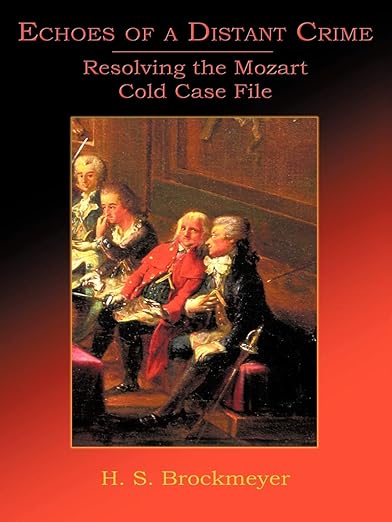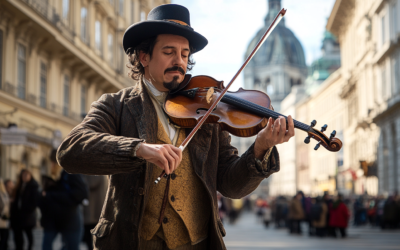Constanze Mozart in Baden bei Wien
🌿 A Spa Town, a Farewell, a Mystery
By H. S. Brockmeyer
The deep, resonant tones of the Pummerin bell in St. Stephen’s Cathedral may have inspired Mozart’s compositions for bass voices, particularly Sarastro in The Magic Flute. As he lived near the cathedral in his final year, the profound sound of the bell might have shaped his musical imagination, infusing his works with a depth that echoes through time.
"You cannot imagine how I have been aching for you all this long while. I can’t describe what I have been feeling — a kind of emptiness, which hurts me dreadfully."
Abstract
In the summer of 1791, just months before Wolfgang Amadeus Mozart’s untimely death, his wife Constanze took refuge in the serene spa town of Baden bei Wien. Sent there to recover from illness and a difficult pregnancy, she became a regular at the famed thermal baths. Yet behind the healing waters and peaceful walks lay a deeper, more turbulent story: suspicions, secrets, and a final summer that would never return. In this vivid and historically rich account, H. S. Brockmeyer reconstructs Constanze’s last months with Mozart, her relationship with Franz Xaver Süssmayr, and the layered emotional world of a woman poised between love, loss, and survival.
Baden bei Wien: The Healing Retreat
Constanze Mozart first visited Baden in 1789 after a fall and illness. Prescribed 60 thermal baths by her physician, she returned there every summer through 1791. The spa town, with its Roman origins and sulphurous springs, became her sanctuary — a place to escape the oppressive heat and stress of Vienna, and later, the site of deeply personal events that would define her final summer with Mozart.
A Composer on the Road
While Constanze recovered in Baden, Mozart embarked on a concert tour with Prince Lichnowsky, hoping for financial relief. Despite noble receptions and musical success, the tour ended in disappointment. Mozart blamed Lichnowsky for debts and poor concert returns, noting bitterly: “From the point of view of applause and glory this concert was absolutely magnificent, but the profits were wretchedly meagre.”
“Find Her a Ground-Floor Room”
Mozart was attentive even from afar. In a letter to Anton Stoll, he requested an apartment for Constanze close to the baths, preferably “on the ground floor.” Her accommodation was eventually secured on Renngasse — today still known as the “Mozart Hof”. There, Mozart composed the Ave verum corpus in June 1791 and often joined his wife for brief visits, working in a garden attic room.
Letters from a Lonely Genius
Throughout the summer, Mozart’s letters to Constanze reveal emotional strain, health concerns, and deep longing. He fretted over her bathing routines, warned against slippery floors, and lamented the distance that separated them: “Even my work gives me no pleasure… because I am accustomed to stop working now and then and exchange a few words with you.”
Shadows in Paradise: The Süssmayr Affair
One shadow loomed large: Franz Xaver Süssmayr. As Mozart’s copyist and frequent companion to Constanze, his presence in Baden sparked both suspicion and jealousy. Mozart’s letters oscillate between humor and hostility: “Give Süssmayr a few sound boxes on the ear from me… it would be a good thing if you were to leave a bump on his nose.”
Later biographers — including Ludwig Hildesheimer — have questioned the nature of Constanze’s relationship with Süssmayr. Her own words, years later, suggest a complex, possibly bitter end to their connection.
A Town of Echoes and Memories
Brockmeyer describes Baden in rich detail — its leafy parks, the women’s bathhouse (now a museum), the Rosarium with 800 varieties of roses. She imagines Constanze wandering through ruins, gathering wildflowers, resting under trees, and savoring moments of calm before everything changed.
Paradise Lost
Mozart died on 5 December 1791. Süssmayr, present at his deathbed, vanished shortly after — never to return to Constanze’s life. In the aftermath, her letters show bitterness and avoidance, while he pursued his career. Whatever bond had formed in Baden, it evaporated with the winter frost.
Final Reflections
Constanze’s spa retreat was not just about health. It was about escape, identity, and perhaps the last flicker of freedom before tragedy and reinvention. In Brockmeyer’s hands, this story becomes more than biography — it becomes a portrait of a woman at the threshold of history.
You May Also Like
The Echo of the Pummerin Bell
The powerful resonance of the Pummerin bell in Vienna may have influenced Mozart’s compositions, particularly Sarastro’s arias in The Magic Flute.
The Hidden Influence of Joseph Boulogne, Chevalier de Saint-George
Joseph Boulogne, known as the “Black Mozart”, was shaping the future of music while Mozart was still struggling for recognition in Paris. But history has buried the significant influence Saint-George had on Mozart’s career, erasing his pioneering style from the narrative.
The Forgotten Viennese Quartets
Attributing Offertorium K.34 to Mozart is not just misleading, it reflects the careless methods used by 19th-century scholars to inflate his legacy. Without an autograph or solid evidence, this work should not be considered part of his output.”
Mozart’s Bassoon Concerto: A Question of Authorship
The Bassoon Concerto K.191 raises more questions than it answers. Long thought to have been composed for a Munich bassoonist, new evidence suggests Mozart had no clear performer in mind. The concerto’s disjointed movements and other dubious compositions attributed to Mozart add further complexity to his legacy
The Uncertain Origins of Mozart’s Early String Quartets
Mozart’s so-called “Milanese Quartets” (K.155, 158, and 159) have long been subject to debate, primarily due to their ambiguous instrumentation and structural weaknesses. Were these works part of a larger series of orchestral divertimenti, hastily repurposed as string quartets? The answer remains elusive, reflecting the young composer’s struggles to find his own voice.
Simplicity, Errors, and the Myth of Perfection
Mozart’s canons are not as complex as often claimed, with notable errors in K.553 and K.554, and the myth of “V’amo di cuore teneramente” K.348 being debunked.







